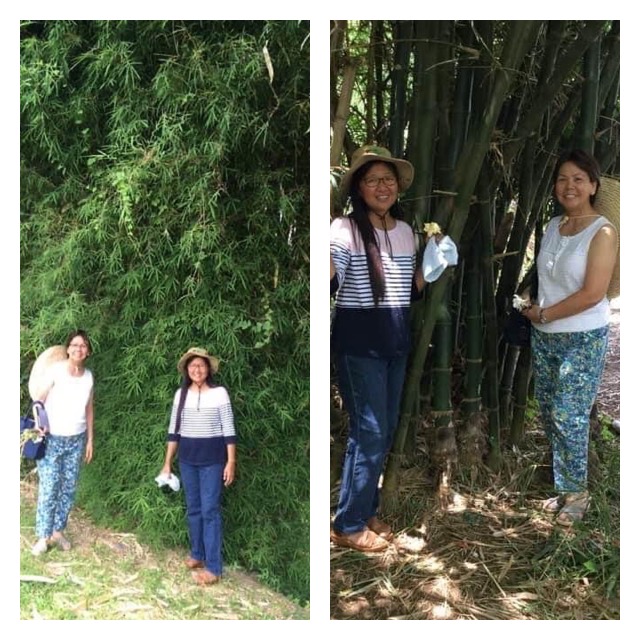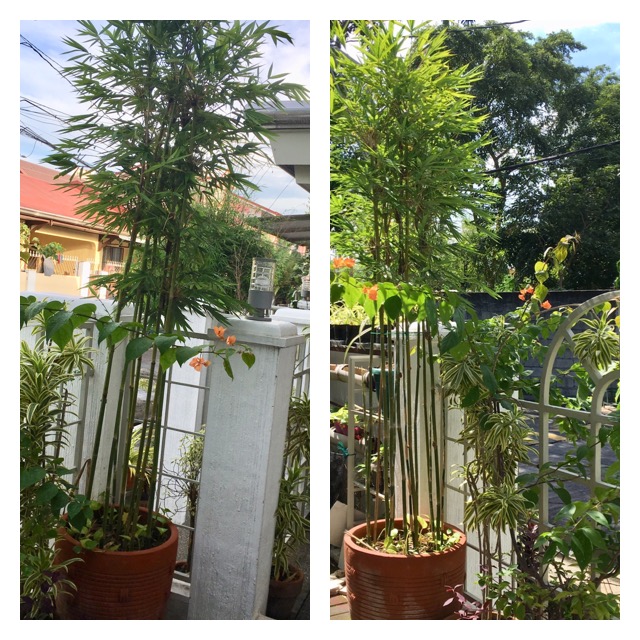MY AFFAIR WITH BAMBOO
Watching the elegant beauty and admirable resilience of bamboo trees can be so physically relaxing, emotionally inspiring and spiritually uplifting.
Like a ballet dancer pirouetting on stage, their trunk sway gracefully and unbroken with leaves moving fluidly in circular motion when the wind is strong and unrelenting. On calmer days, they stand tall and quietly like a person of honor and integrity, with only the leaves creating a rustling sound in response to the whisper of a gentle breeze.
INSPIRED BY THE BAMBOO EXPERT
I was first fully oriented about bamboo when my husband and I visited Dr. Bing Caasi-Lit, a scientist and international speaker on bamboo at the UP Los Banos Institute of Plant Breeding.
Known as the Bamboo Lady of Los Banos and whose father is also known as the Father of Bamboo in Davao, she excitedly showed us the different bamboo varieties from ornamental to industrial, endemic to foreign, as well as the growth behavior of each kind.
After this, we went to a gardener growing and selling ornamental bamboo seedlings at three times less than the price being offered in Manila.
Dr. Lit's overflowing passion and persistent advocacy for the promotion of bamboo planting all over the country, not only for its proven environmental impact but economic as well, was so infectious that I went home with a resolve to do my share in growing a variety or two.
THE WHY, WHAT AND HOW OF PLANTING ORNAMENTAL BAMBOO
After more than a year of patiently caring, transplanting, and trimming my bamboo trees, I am sharing my experiences as a guide for those considering to plant them in the garden.
1. Determine your purpose for planting bamboo. The Pole Bamboo variety I planted is ideal for trimming into different shapes and can be a unique feature in your garden. It can also grow as tall as a two-storey building and can serve as a hedge to cover unsightly structures or allow you privacy from public view.
2. Know the growth characteristics of the bamboo variety you are planting. Most bamboo varieties have roots that are highly invasive and can hinder the growth of nearby plants. Others like the Pole bamboo do not spread so much. The Thai variety has leaves that spread like an umbrella and does not grow very tall so it is ideal if you want shade in the garden. The roots however are invasive so I decided to uproot them from the ground and transfer to a huge jar.
3. Decide how tall you want the bamboo to grow. Based on my readings, bamboo can lower humidity by at least 60%. So when I first planted bamboo, I let them grow as high as it could, providing us so much shade in summer and cooling our west-facing bedroom significantly. However, when they grew very tall, it became difficult for me to trim the branches without the risk of a fall from the ladder, so I cut the top about two feet below the ground floor gutter. Thereafter, whenever new branches appear, I trim them up to a height that is reachable using only the Long-Reach Pruner I bought from an online store without having to use a ladder. This also prevents dry leaves getting into the gutter during its shedding off season.
4. Install concrete barrier around your bamboo tree. Whether it is a clumping or running bamboo, it is always best to put a concrete or hard wood barrier around the base of the bamboo to prevent the roots from spreading around the garden. I learned my lesson after ignoring the advice of friends who have grown bamboo in their garden. Uprooting a colony of six feet tall bamboo is a difficult task even for a strong, able-bodied male gardener.
5. When trimming to achieve your desired height, cut the stem right after the node of the bamboo. From the node will grow a new colony of bamboo stems which you can let grow and later trim to your desired height while they are still young and soft. The node should be around two feet below the maximum height of the bamboo you want to achieve.
6. Show off the bamboo skin. During dry season, the skin is crisp and can easily be removed by gently creating a slit from node to node using the tip of a Zigzag edge knife, then peel off the whole skin. During wet season, the skin is soft and gently rubbing the back of a knife against the skin will break it into particles like dead skin on a human body when rubbed with a pumice. Using the back of a knife prevents causing scratches on the bamboo trunk. Rub the trunk with used cloth and baking soda after to remove skin debris and to let the bamboo color shine and glow. This is a laborious job that can test your passion and love for bamboo.
7. Don’t throw away bamboo parts after trimming. The big bamboo stems can be used as bamboo poles to hang your pots in the garden as they are very sturdy and durable. I use the thinner stems to support and guide new growing plants or as trellis for seasonal vines. The soft topmost stems can be a beautiful green accent in the living room and can stay fresh for a week when placed in a vase with water, emitting the scent of freshly cut grass that is good for the health; on some occasions, I use them as juice stirrers in the same way I use the more mature ones for mixing paint or insecticide with water. The more mature leaves can be left to dry without shedding off from the branches for months and can be sprayed with paint for decor purposes. The dry, fallen leaves can be used as mulch to cover the base of plants and keep the soil moist during dry season. My Christmas trees for this year are made out of dried bamboo stems.
8. Snakes are attracted to bamboo. The bamboo is cold at day time and warm at night time so it is not uncommon to see snakes visiting areas where bamboo grow abundantly. Lemon grass, marigold plant, oregano and garlic emit a certain scent that repels snakes and can be planted around them. Using gravel as ground cover also prevents snakes as they do not like to slither on rough surfaces. Cats and dogs also prevent snakes from coming near bamboo trees.
9. Bamboo are fast growers. From the original two stems I planted, new shoots started to grow after they became stable. Once you achieve your desired number of stems in a colony of bamboo stems, cut the new stems at the base to stop them from further multiplying. Cutting the upper stems at the top will induce new stems that can grow a meter in a week or two. Don’t wait for the stems to grow beyond the height you want; otherwise they will mature and become harder to cut.
Bamboo can be high maintenance plants and you need to be patient in caring for them. I find it very fulfilling and worth the time I spend even just watching and seeing them grow beautifully. I am grateful to my husband for giving me his blessings without resentment nor jealousy to this passionate bamboo affair.
May you have your share of passionate love and care this Christmas and always!
Apple Bleza-Morales
About the Author:
Apple is passionately interested in community greening and beautification, organic and ornamental gardening, environment protection and preservation as well as related arts and crafts. She shares her professional, personal and travel experiences to spread knowledge and information in these areas which may not be accessible to all who are similarly interested and aims to inspire others to develop and create new ideas from her blogs.
Apple holds a Master's degree in Industrial Relations from the University of the Philippines. She held leadership roles in Human Resources during her employment with the private sector, developing and implementing HR and Organizational systems that help employees to grow their careers and employers to achieve a mutually beneficial engagement.
Photos by: Maybelle B. Morales














Waaaaaah…love them, too…so I bamboo-zled you when you already knew them by heart, hahaha…Sabi na sa ‘yo, I do like an ipo-ipo when i get involved, hehehe…here’s to bamboo journeys! Ako na lang sa Xmas stuff…
ReplyDelete